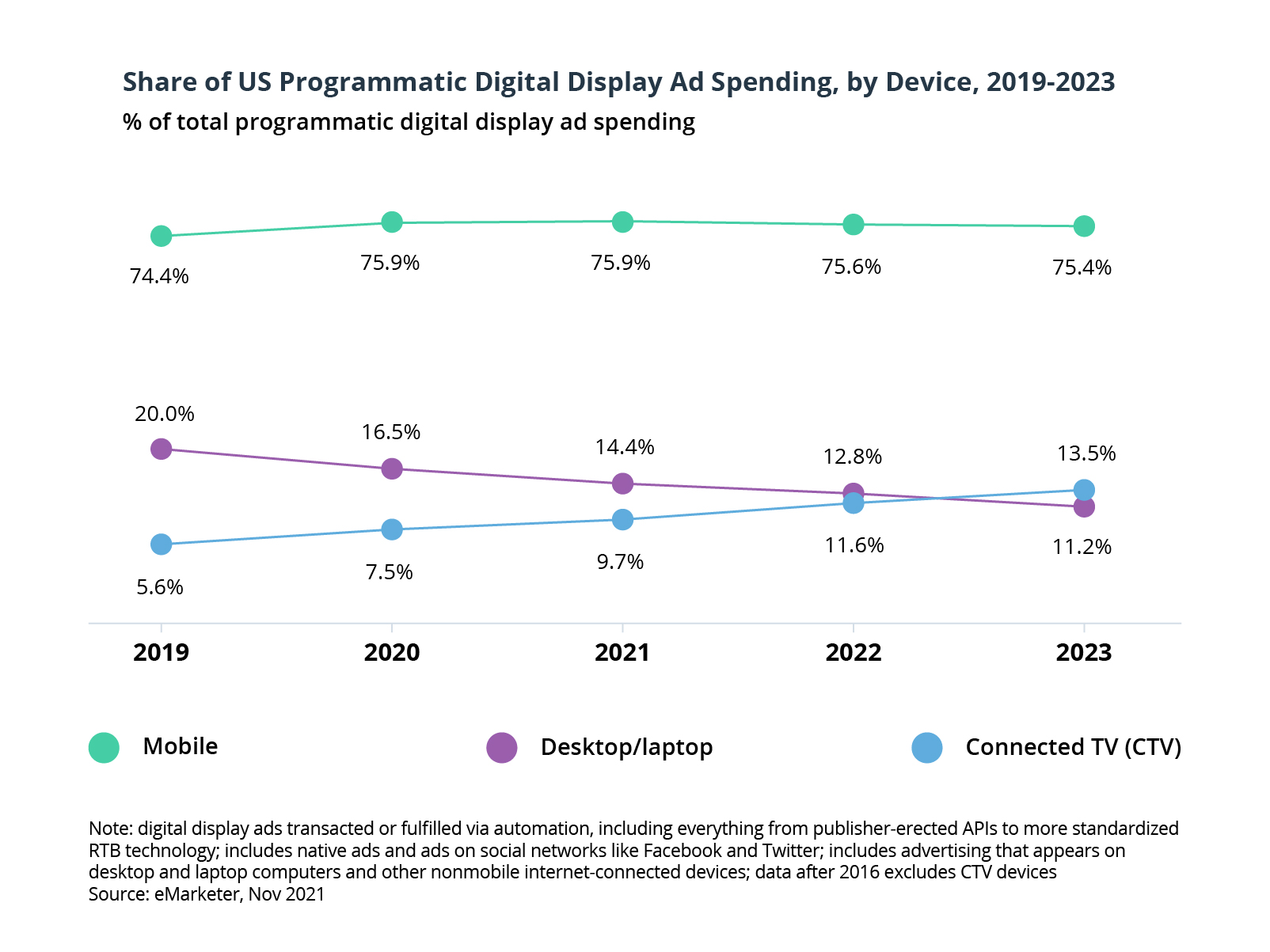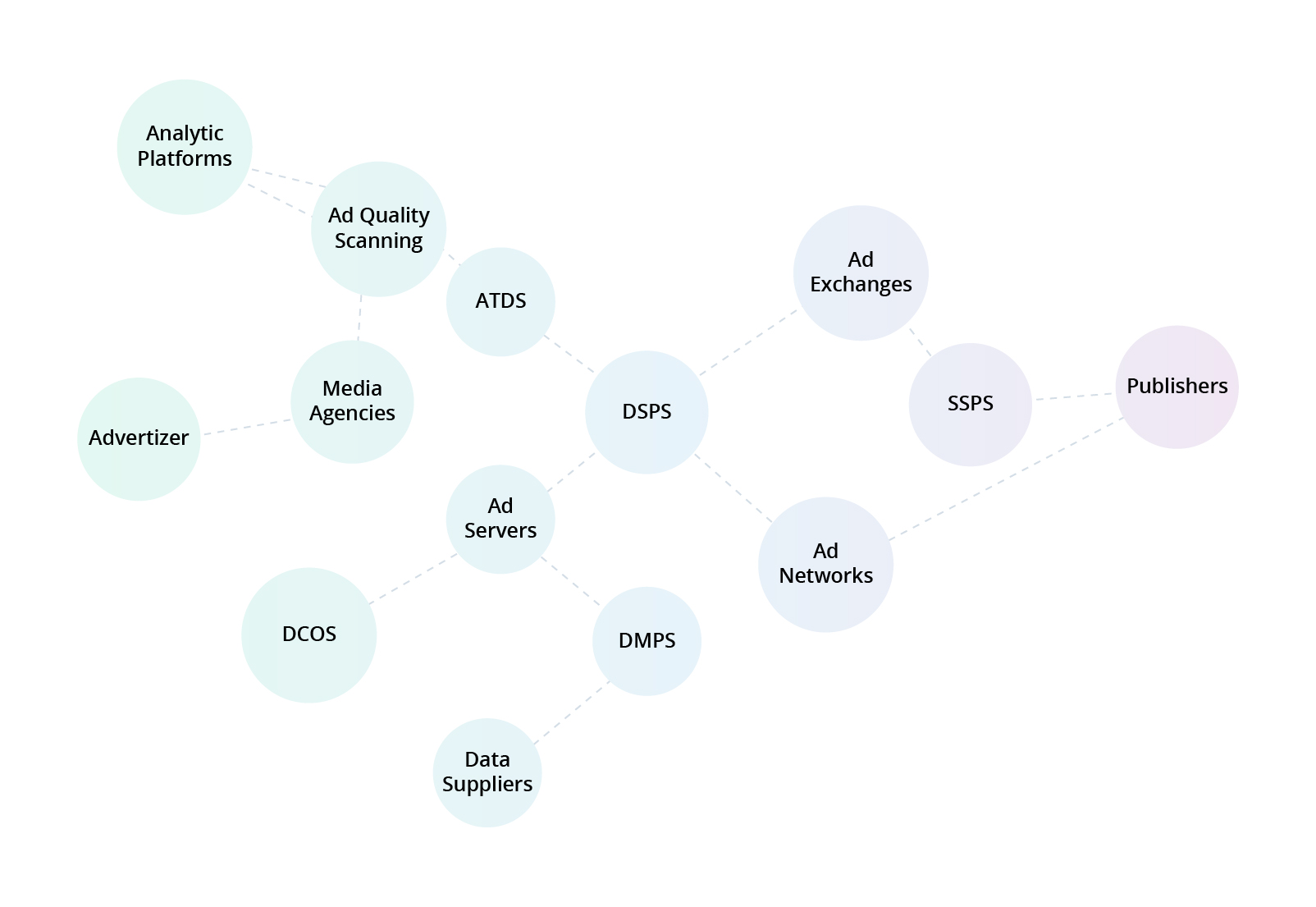In a world where consumers are more discerning than ever and their attention spans are fleeting, advertising is evolving at a crazy pace. Traditional methods no longer cut it. This is why custom AdTech development has appeared, targeting them at precisely the right audience, showing them at the ideal moment, and tailoring them with just the right message.
For example, you might build a mobile ad platform or audio streaming ad insertion solution. Today’s media offers unlimited advertising opportunities for AdTech developers. In this sphere, algorithms, analytics, and automation are the key to success. Learn how data-driven decision-making is revolutionizing ad campaigns and driving results like never before.
Understanding AdTech software: What it is and how it powers advertising
The COVID-19 pandemic transformed e-commerce, shaping consumer expectations and providing advertisers with fresh insights into customer behavior. Google removed third-party cookies from web browsers in 2022, and the effects of this decision are creating another favorable trend for commerce media. Let’s define what we mean by that.
Commerce media has its roots in affiliate advertising—partnerships in which publishers link their content to commerce opportunities to provide an enhanced experience for consumers. The category is now rapidly expanding to include retail media networks (RMNs), third-party ad platforms that retailers set up on their websites. It also includes “shoppable ads” that enable people to purchase products through online or mobile ads, and “live commerce” or “shoppable TV,” where viewers can interact with video content and buy products directly from their TV or device screens.
As we step into an era increasingly driven by AdTech, it’s worth noting that first-party data will emerge as a potent competitive advantage. But let’s first define some terms. Here is what Gartner says about AdTech:
Ad tech is a set of technologies used for managing advertisements across channels, including search, display, video, mobile and social, with functions for targeting, design, bid management, analytics, optimization and automation of digital advertising.
Today, AdTech encompasses several prominent trends, including connected TV (CTV), hyper-personalization, augmented reality (AR), virtual reality (VR), geotargeting, and integrated customer journeys.
Additionally, programmatic advertising, driven by algorithms and data, enhances ad campaigns’ success and efficiency. Native advertising, which seamlessly integrates sponsored content into a website’s layout and style, is also experiencing a surge in popularity.
Moreover, retail media networks (RMNs), or third-party ad platforms that retailers launch on their websites, come into play. For example, Amazon has used such a strategy to go beyond sponsored ads on its shopping platform. This is one of the strategies that businesses can apply for selling sponsored off-site and on-site advertisements.

Source: Commerce media: The new force transforming advertising, by Marc Brodherson, Tiffany Chen, Jon Flugstad, and Quentin George, McKinsey
In today’s digital-driven advertising world, the traditional direct negotiation between publishers and advertisers has given way to programmatic advertising, automating the buying, selling, and fulfilling of advertisements. Principal challenges include:
- emerging agency trading desks (ATDs) and demand-side platforms (DSPs) on the buyer side
- managing campaigns and purchases as well as supply-side platforms (SSPs) and ad exchanges
- overseeing publisher inventory and facilitating ad inventory trading

Source: Opportunities for advertisers, marketers and publishers in a cookie-less world, Jorge Manuel Xavier
Programmatic non-auction-based automated advertising is dominated by giants such as Google, Facebook, and Amazon, emphasizing the importance of personalized targeting, which involves tracking users’ online behavior, typically through cookies, to deliver tailored advertisements.

Source: Insider Intelligence
It’s no wonder that the AdTech market is expected to reach $1.9 trillion globally by 2028 according to KBV Research, growing at a 14.4% compound annual growth rate within the forecast period.
By the end of 2023, overall programmatic display ad expenditure in the US is projected to reach $141.96 billion annually. What opportunities enable that growth?
Unveiling the advantages of AdTech software systems
Two critical steps are imperative to maximize the benefits of AdTech software: first, seek a proficient AdTech developer with relevant expertise and experience; second, establish clear objectives for integrating AdTech software into your business. The fusion of a dependable tech partner and a well-defined vision is essential to unlock the advantages offered by AdTech app development:
- Enhanced advertising: AdTech enhances precision in reaching the right audience with compelling content, increasing user engagement.
- Streamlined campaign efficiency: AdTech development boosts the efficiency of marketing campaigns, providing a panoramic view for optimization.
- Deeper funnel insights: Leveraging data, AdTech enables personalized storytelling aligned with a consumer’s position in the marketing funnel.
- Optimized budgeting: Investment in AdTech product development translates into improved budgeting, with accurate insights leading to higher conversion rates.
- Precise campaign monitoring: AdTech app development empowers advanced tracking and monitoring, enabling strategic ad placement for superior performance.
- Cross-platform consistency: AdTech software ensures consistent functionality across various platforms, reinforcing brand representation and audience targeting.
- Buyer’s journey insights: AdTech development offers comprehensive insights into reaching consumers at different stages of the buyer’s journey, enabling tailored marketing strategies for optimal engagement.
Solving advertising challenges
Today, AdTech faces significant challenges that must be addressed for enhanced profitability and revenue growth, from privacy concerns to catching the new opportunities that gaming and connected TV (CTV) bring.
Privacy prioritization
The AdTech industry is grappling with significant changes, notably the decline of third-party cookies driven by user privacy concerns. Apple users increasingly opt out of data tracking, while Google is phasing out cross-site tracking identifiers. Advertisers must adapt by exploring alternatives like contextual targeting and embracing projects like Google’s Privacy Sandbox.
Transparency demands
Transparency issues in digital advertising require attention. Brands want to know how much of their ad spend goes to intermediaries. Solutions like the Interactive Advertising Bureau’s Fee Transparency Calculator offer a granular evaluation of programmatic advertising costs.
CTV opportunities
Connected TV presents a lucrative opportunity to AdTech players, with an 81% increase in CTV viewing time globally. Advertisers, however, face tasks and challenges, such as measurement, ad fraud, and fragmented markets. Solutions involve post-production brand integration and advanced targeting to optimize ad delivery.
Ad fraud concerns
The CTV boom also concerns ad fraud, with nearly 24% of programmatic CTV ads in the USA being invalid traffic. Industry standards and tools like ads.txt are crucial for addressing this issue.
Low click-through rates
Low click-through rates (CTR) continue to plague ads, necessitating more engaging formats like innovative designs, interactive videos, and native advertising to combat audience disinterest.
Gaming’s emergence
Virtual reality offers unique opportunities, but advertisers must focus on providing gamified digital experiences to effectively engage users. Online-to-Offline-to-Online (O2O2O) and omnichannel shopper approaches can monetize the gaming space.
Key features of the AdTech software ecosystem
Let’s define some of the AdTech tools that serve distinct functions in the digital advertising ecosystem:
Demand-side platforms (DSPs) use real-time bidding to purchase digital ad space, linking advertisers with ad networks to ensure precise targeting and delivery.
Supply-side platforms (SSPs) empower publishers to programmatically sell ad space, connecting them with ad exchanges and facilitating bidding by DSPs.
Ad exchanges are marketplaces that unite DSPs and SSPs, streamlining automated ad space transactions.
Ad networks act as intermediaries, enabling DSPs and SSPs to efficiently buy and sell ad inventory.
Ad server platforms store digital assets and dictate when and which ads are displayed on websites or apps.
Data management platforms (DMPs) bridge AdTech and MarTech, collecting and organizing user data and enabling advertisers to create behavior-based audience segments.
Ad forecasting software tools leverage consumer behavior data to assist advertisers in optimizing their ad expenditures.

While the terms AdTech and MarTech are sometimes used interchangeably, AdTech primarily focuses on buying, selling, managing, optimizing, and analyzing digital ads, distinguishing it from marketing technology.
MarTech, short for Marketing Technology, refers to the software and technology tools that marketers use to plan, execute, and measure marketing campaigns and activities. MarTech encompasses a wide range of technologies and platforms designed to streamline marketing processes, improve efficiency, and enhance the overall effectiveness of marketing strategies.
| Aspect | AdTech | MarTech |
|---|---|---|
| Use cases | Paid ad campaigns | Unpaid promotions |
| Purpose | Enable media purchasing, enhance user ad investment efficiency, or boost revenue from monetization | Streamline the execution of comprehensive marketing strategies and automate repetitive marketing tasks |
| Channels | Display advertising, video advertising, social media advertising, PPC, CTV, digital-out-of-home (DOOH) | Social media, direct sales, email, conversational marketing, video marketing, and content marketing |
| Targeting | Using third-party data, temporary and approximate visitor profiles, and unidentified recipients | Using first-party data, users are already identified and possess permanent yet regularly updated profiles |
| Pricing | Consistent monthly fee, advertising spend commission, and hidden bid markups | Consistent monthly / yearly fee |
| Users | In-house media buyers, advertising agencies, website proprietors, application developers, and advertising networks | In-house marketing teams, freelance marketers of all kinds, sales teams |
| Examples | Ad server, data management platform, demand-side platform | Social media scheduling tools, email marketing automation platforms, and chatbots |
Going beyond the basics: Advanced modules to supercharge your AdTech system

AdTech companies have a rich history of using the power of machine learning algorithms. Let’s delve into some advanced modules you can use to supercharge your AdTech system right now:
Programmatic auction optimization
Ad networks can sometimes hinder your programmatic auctions due to high latency, poor inventory, or incorrect setup. However, machine learning tools like Google Smart Bidding can significantly enhance your auction outcomes. Google Smart Bidding employs machine learning algorithms to optimize your auctions based on your specific goals, prioritizing cost-per-auction, conversion value, or return on ad spend (ROAS).
You can even set performance targets for different devices (desktop, mobile, tablet), and the technology will dynamically adjust networks, bids, and impressions to meet them.
Meta’s Campaign Budget Optimization is another handy tool that simplifies budget management by automatically distributing your central budget throughout a campaign, ensuring your ad spend goes to the best-performing ad networks.
Context-relevant ads
Machine learning technologies excel at identifying the most influential visual content for specific audience segments, allowing for precise ad content matching and successful creative delivery.
Take Luna (formerly Bidalgo), which uses AI-based algorithms to determine winning ad creatives by analyzing images and videos to identify high-performing assets and the reasons behind their effectiveness. This technology can suggest colors, concepts, images, and other variables for your marketing campaigns.
Dynamic content
Algorithms can dynamically modify elements of your ads to suit individual user preferences. For instance, Meta’s dynamic ads display different visual media and ad formats (carousel or image collections) based on user preferences.
Google’s AdSense Auto ML system analyzes web pages to select ads with a higher cost per mille/thousand (CPM) and those likely to enhance the user experience. Meta’s text optimization system uses machine learning models to tailor text variations, fonts, and sizes to the user’s device. Additionally, it can automatically translate ads into different languages to reach international audiences.
Targeted campaigns
Machine learning is instrumental in personalized display advertising campaigns that cater to specific customer segments. You can refine your target audience by feeding your AI systems with data from platforms like Google, LinkedIn, and Meta. Another example of supercharged AdTech systems is Abreva, a cold sore medicine company that uses Google’s user data to train machine learning algorithms. This approach allowed Abreva to craft over a hundred ads based on content viewers watch on YouTube, resulting in a remarkable 342% search interest lift across YouTube and Google.
Inventory optimization
Effective management of your advertising inventory is crucial for a successful monetization strategy. For example, Google Ad Manager employs machine learning and forecasting to optimize your ads and maximize your sell-through rates. It also incorporates seasonal trends to fine-tune forecasts and help you maximize your inventory.
Fraud detection
Digital ad fraud is a growing concern and is projected to cost over $100 billion to users by 2023 globally. Scammers employ various tactics, including bot farms, SSAI attacks, SDK spoofing, and click spamming.
Take Cookies Digital, a mobile monetization company, for example. They experienced profit losses due to fake traffic. Meanwhile, machine learning algorithms are invaluable for processing big amounts of data to screen fraudulent activities.
By adopting fraud detection software, Cookies Digital successfully tracked activities across multiple ad campaigns, preventing incent traffic (traffic generated through a system of rewards), blocking redirects, and ensuring compliance with brand protocols. As a result, Cookies Digital reached a 1,200% annual return on investment (ROI).
A step-by-step guide to building custom AdTech software from scratch

As an AdTech product development company, you should first determine the type of product you’re going to build and the market needs it addresses. Whether it’s a demand-side platform for advertisers, a supply-side platform for publishers, or an ad network facilitating media trading, clarity on your product and its target audience is essential.
Step 1: Budgeting
Remember that generating profit from your services results from solving your customers’ problems, which requires meticulous planning. Begin by answering key financial questions: How much income can you expect in the first year? What are your projected expenses? What’s the difference between income and expenses, i.e. your profit?
Step 2: Assembling your team
Assembling a skilled team is crucial. Building an AdTech platform requires professionals in various areas, from technical development to design, testing, and technical support. Developers and technical specialists handle real-time bidding, data processing, and ad serving. At a later stage, SEO specialists, marketers, copywriters, and customer service representatives may be required, raising the question of whether to outsource or hire in-house.
Step 3: Choosing a technology stack
The technology stack you choose is pivotal. Since AdTech applications often require real-time data processing and analytics, a robust and scalable technology stack is crucial. Standard technologies that any AdTech development company will work with include:
Programming languages: Java, JavaScript (Node.js), Go, Python. At this point, you need to opt for a programming language depending on your project.
Frameworks: You should also choose a web framework (Ruby on Rails, Django, or Express.js).
Databases: Use high-performance databases (PostgreSQL, MongoDB, or Cassandra) for data storage.
Data streaming: If your AdTech platform handles real-time data, Apache Kafka or RabbitMQ can be used for message queuing and data streaming.
Cloud services: Cloud providers such as AWS, Google Cloud, and Azure offer scalable infrastructure and services that can be cost-effective.
Data management and analytics: Effective data management is central to AdTech. You must collect, store, and analyze vast amounts of data in real time. Consider employing big data technologies and analytics platforms like Apache Hadoop or Spark, or using specialized AdTech analytics tools.
Step 4: Compliance and privacy
Make sure you adhere to data protection laws and regulations, especially if you’re handling user data. Your product should comply with laws and regulations such as the California Consumer Privacy Act (CCPA), the General Data Protection Regulation (GDPR), and the Children’s Online Privacy Protection Act (COPPA). Also, consider developing mechanisms for user consent, data access, and data deletion.
Step 5: User interface (UI) and user experience (UX) design
Your platform’s success hinges on a user-friendly interface, so the UI/UX team should create a visually appealing, responsive, and intuitive design. Consider mobile responsiveness, as many users access AdTech platforms via mobile devices.
Step 6: Development and testing
During development, follow coding best practices, including code reviews and version control (for example, using Git). Prioritize automated testing to catch bugs early, and apply continuous integration and continuous deployment pipelines for smoother development workflows.
Step 7: Real-time bidding integration
If your AdTech software involves real-time bidding (RTB), you’ll need to integrate with ad exchanges, supply-side platforms (SSPs), and demand-side platforms (DSPs). Implement APIs and protocols such as OpenRTB for seamless interactions with these systems.
Step 8: Quality assurance
Develop a comprehensive quality assurance (QA) strategy, including unit testing, integration testing, performance testing, and security testing. Pay close attention to security, as AdTech platforms handle sensitive data.
Step 9: Scalability
Design your architecture with scalability in mind. Utilize cloud-based services for autoscaling based on demand. Implement load balancing to distribute traffic evenly across servers. Regularly monitor performance to identify scalability bottlenecks.
Step 10: Launching and marketing
Launch your AdTech platform with a well-defined marketing strategy encompassing content marketing, search engine optimization (SEO), and online advertising. Consider partnerships with influencers or industry events to increase visibility.
The tomorrow of advertising: Predicting the future of AdTech and MarTech
The AdTech landscape has experienced accelerated innovation in response to the pandemic, nudging consumers to embrace digital platforms even more rapidly than before. Notably, investments in CTV in the US surged by nearly 60% year over year in 2021, surpassing $14 billion. Consequently, advertising has evolved into an intricate challenge.
The dynamic AdTech landscape has spurred innovative technological solutions. Unlike the past, where companies developed technology and awaited adoption, today’s innovation often outpaces adoption rates, presenting an exciting opportunity.
Below, we explore key technology trends reshaping the programmatic advertising landscape:
AI and ML revolutionizing programmatic advertising
Artificial intelligence (AI) and machine learning (ML) are set to revolutionize programmatic advertising. These technologies enable advertisers to analyze vast datasets, offering accurate predictions regarding user behavior and purchase paths. With its lightning-fast data processing capabilities, AI will correlate user information with ad placement timing and formats, significantly enhancing advertising effectiveness and reducing customer acquisition costs.
Digital out-of-home (DOOH) leveraging mobile location data
The trend of DOOH advertising fueled by mobile location data has gained momentum in recent years and will continue to evolve. DOOH bridges the gap between online and offline advertising channels in the user journey. By leveraging advertising technology, DOOH enhances the offline customer experience and drives offline conversions.
Rise of programmatic TV, podcasts, and programmatic audio
The shift in digital content consumption from traditional cable to over-the-top (OTT) services like Netflix and Amazon Prime is reshaping the advertising landscape. Advertisers must capitalize on both channels using programmatic advertising. As multimedia content consumption converges online (across mobile devices and internet-connected TVs), a programmatic approach to television, guided by data insights, becomes increasingly pivotal for efficiently targeting and delivering ads to consumers.
Ready to spice up your advertising game?
The advertising world is undergoing a profound transformation, propelled by data-driven decision-making and the relentless innovation of AdTech software. As consumer behavior evolves, AdTech’s ability to deliver personalized, efficient, and engaging advertising experiences is becoming increasingly crucial.
By harnessing advanced technologies like machine learning, AdTech companies are redefining the future of advertising, offering solutions that optimize auctions, deliver context-relevant ads, create dynamic content, and enable targeted campaigns.
While AdTech faces privacy concerns and fraud challenges, it promises a future where ads are seen and genuinely connect with audiences. Whether you’re an advertiser, publisher, or tech enthusiast, embracing AdTech’s capabilities is vital to staying ahead in the dynamic advertising world.
Contact our team today and discover how we can tailor AdTech software to supercharge your campaigns, optimize your budget, and precisely reach your audience.




